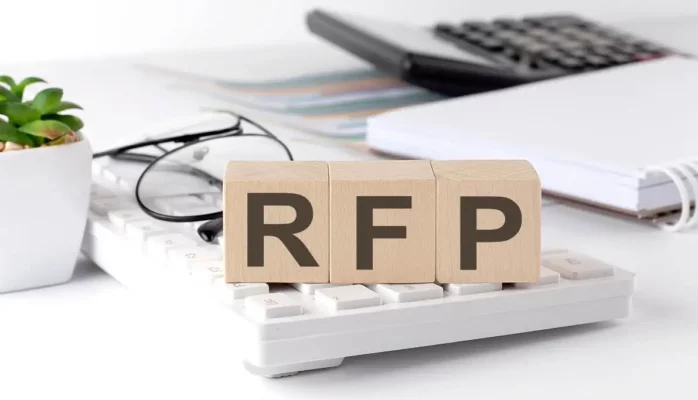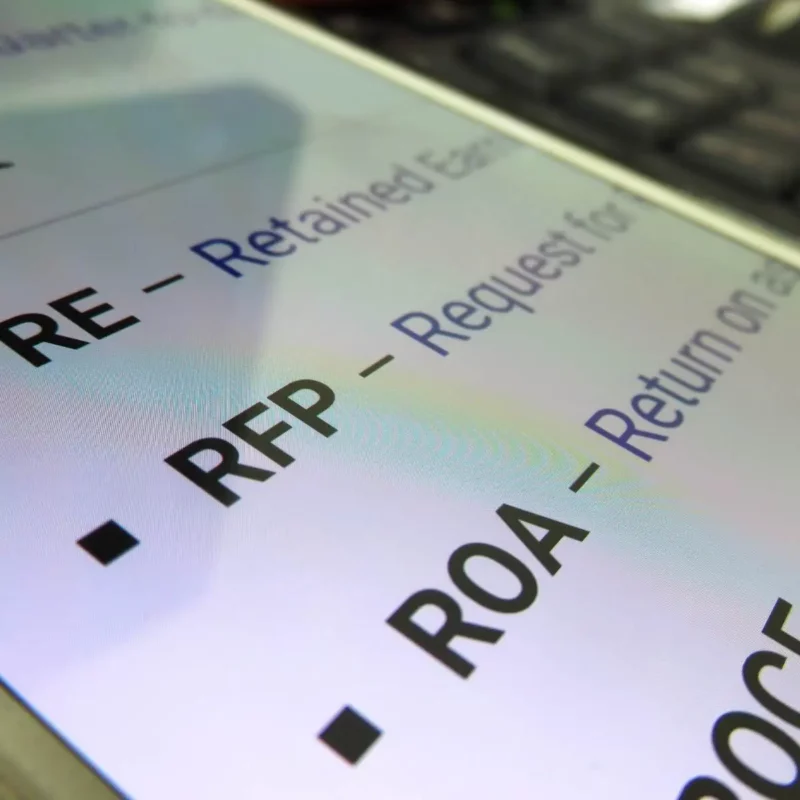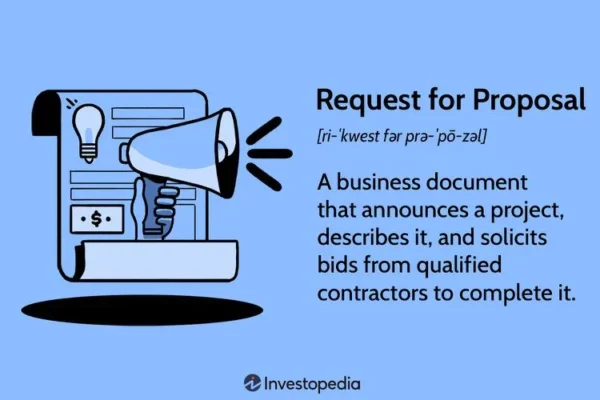Writing a Request for Proposal (RFP) for industrial automation is crucial for getting the right solution for your manufacturing needs. Your RFP needs to be clear and detailed so that vendors understand exactly what you need. This way, you can attract qualified vendors who can meet your specific requirements.
Whether you’re automating a single process or revamping your entire production line, this guide will help you write an effective RFP. You’ll learn how to define your objectives, set clear expectations, and confidently evaluate vendor proposals. By following these steps, you can ensure you make the right choice for your automation project.
What Does an RFP Mean?
An RFP, or Request for Proposal, is a document you use to request bids from vendors for a specific industrial automation project. When you issue an RFP, you clearly state your project requirements, goals, and deadlines. This allows you to invite qualified suppliers to propose their solutions.
In industrial automation, an RFP is crucial when you’re looking to purchase complex systems like robots or vision systems. It helps you gather detailed proposals, including costs, technical specs, and how the vendor plans to implement the solution. This way, you can compare options and choose the one that best meets your needs.
By issuing an RFP, you also encourage vendors to compete, which can lead to better pricing and innovation. This process ensures that the solution you choose fits your technical needs and budget while helping you achieve your automation goals.

Understanding Your Project Requirements:
Define Your Objectives:
Start by defining what you want to achieve with automation. Are you aiming to boost production efficiency, reduce downtime, or improve safety? Be clear about your goals so you can focus on the right solutions and communicate your needs to vendors.
Identify the Scope of Work:
Determine which tasks or processes you need to automate. Are you automating a single process, or do you need full automation across your production line? Clearly outline whether you require partial or full automation. This helps vendors provide accurate proposals.
Budget Considerations:
Set a realistic budget for your project. Think about all costs, including equipment, installation, and training. Knowing your budget upfront helps you narrow down your options and avoid overspending.
Timeline:
Establish a clear timeline for your project. When do you need the automation system operational? Define your start and completion dates to keep the project on track. A well-planned timeline also helps vendors understand your schedule and plan their work accordingly.
By understanding these elements, you’ll be ready to create an RFP that meets your needs.
Structuring Your RFP Document:
Cover Page & Introduction:
Start with a brief introduction on the cover page. Mention your company, the project, and why you’re issuing this RFP. This gives vendors a clear idea of what you need right from the start.
Project Overview:
Describe your project in detail. Explain your current situation and what you want to achieve with automation. Be specific about the issues you’re facing and the results you expect.
Technical Requirements:
List all the technical details you need. Include the types of robots, software requirements, and compatibility with your existing systems. Specify any industry standards that must be met. Clear technical specs help vendors understand if they can meet your needs.
Evaluation Criteria:
Explain how you’ll evaluate the proposals. Focus on what matters most to you, like the vendor’s experience, technical capabilities, cost, and support services. This helps vendors tailor their proposals to your priorities.
Submission Guidelines:
Give clear instructions for submitting proposals. Specify the format, deadline, and any required documents. This ensures you receive proposals that are easy to review and compare.
By structuring your RFP this way, you make it easier for vendors to understand your needs and respond effectively.
If you’re looking for a quick overview of what an RFP is, you can read the summarized version of this blog to get the essentials in a few minutes. (Investopedia, 2024)
Detailing the Scope of Work:
Task Description:
Clearly list the tasks you want the automation system to perform. Break each task down in detail. For example, specify if the system will handle machine-tending, packaging, or palletizing. Being specific helps vendors provide solutions that match your exact needs.
Equipment and Technology Needs:
List the exact machinery, robots, and software you need. Be clear about the types and models you require. If you prefer certain brands or technologies, mention them. This ensures vendors know exactly what equipment you expect for the project.
Integration Requirements:
Explain how the new automation system should work with your existing setup. If you already have machinery or software in place, describe how the new system must integrate with these. Specify any protocols or software platforms that need to be compatible. Clear integration details help avoid problems during installation.
Performance Metrics:
Define the key performance indicators (KPIs) you’ll use to measure the success of your project. This could include metrics like production speed, error rates, or downtime reduction. Be specific about what you’ll use to evaluate the system’s performance. Clear KPIs help vendors understand your expectations.
By detailing the scope of work, you make sure vendors know exactly what you need, helping them propose the right solutions.
Need Help with Your Automation Project?
Navigating budgets, timelines, and creating the perfect RFP can be challenging. Let Alina, your AI Automation Consultant, guide you through the process. Get expert advice tailored to your specific needs. Ask Alina today and ensure your project is on the path to success!
Vendor Qualifications & Requirements:
Experience & Expertise:
Ask vendors to provide examples of similar projects they’ve completed in your industry. You need to see proof that they have the experience to handle your specific needs. This helps you judge if they are the right fit for your project.
Technical Support & Training:
Make it clear that you need ongoing technical support and maintenance. Your team will also need training to use and maintain the new system. Ensure that vendors include these services in their proposal.
Financial Stability:
Request financial statements or other evidence of financial stability. You need to be sure the vendor can support your project from start to finish. A financially stable vendor is more likely to deliver reliable service and meet your requirements.
Compliance & Certifications:
Confirm that vendors meet all necessary regulations and have the required certifications. This is important for ensuring safety and compliance with industry standards. Ask vendors to provide proof of these certifications in their proposal.
By clearly stating your vendor qualifications and requirements, you ensure that you only receive proposals from vendors who are fully capable of handling your project.
Cost Structure & Payment Terms:
Breakdown of Costs:
Ask for a clear breakdown of all costs. This should cover everything, including hardware, software, installation, and any extra services. You need to see exactly what you’re paying for. Make sure vendors list each item separately so you can easily compare their proposals.
Payment Schedule:
Set clear payment terms. Define when payments are due, such as an initial payment when equipment is delivered, another after installation, and the final payment after successful testing. Having specific payment milestones helps you keep the project on track and ensures you only pay when key stages are completed.
Warranty & Service Agreements:
Request detailed information on warranties and service agreements. You need to know what is covered and for how long. Also, ask about post-installation services like maintenance and support. This ensures you have the necessary backup once the system is operational.
By being specific about your cost structure and payment terms, you ensure you fully understand the financial commitment and keep the project running smoothly with vendors meeting your expectations.
Timeline & Project Management:
Project Phases:
Break your project into clear phases. These might include design, implementation, testing, and training. Define what each phase includes and what you expect to be done. This keeps you and your vendor aligned throughout the project.
Milestones:
Set specific milestones with deadlines. For example, you might want the design phase completed by a certain date, followed by installation and testing. These milestones help keep the project on schedule and make it easier to track progress. Ensure your vendor agrees to these deadlines.
Communication Plan:
Establish a communication plan for regular updates. Decide how often you want updates and in what format, like weekly meetings or progress reports. Clear communication helps address any issues quickly and keeps everyone informed about the project’s status.
By setting a detailed timeline and clear project management guidelines, you make sure your automation project stays on track and runs smoothly.
Legal & Contractual Requirements:
Confidentiality Agreement:
Include a confidentiality agreement to protect your sensitive information. Clearly state that any data or trade secrets you share must be kept confidential. This ensures your company’s information stays secure and isn’t shared with anyone else.
Liability & Risk Management:
Outline the vendor’s liability if there are delays, failures, or other issues with the project. Specify what happens if they don’t meet the agreed standards or deadlines. This protects you from risks and makes sure the vendor is held accountable.
Contract Termination:
Define the conditions for ending the contract. Specify when and why either you or the vendor can terminate the agreement, such as missed deadlines or failure to meet requirements. Include any penalties or obligations that apply if the contract is ended. This gives you a clear way to end the agreement if things don’t go as planned.
By setting these legal and contractual terms, you protect your interests and ensure that both you and your vendor clearly understand the agreement.
Evaluation & Selection Process:
Proposal Review:
Explain how you will review and score each proposal. Set clear criteria to evaluate important factors like experience, technical capabilities, cost, and support services. Use a scoring system to compare proposals fairly and consistently.
Vendor Presentations:
Consider asking shortlisted vendors to give a presentation or demo. This lets you see their solutions in action and ask questions directly. It’s a good way to make sure the vendor understands your needs and can deliver what you require.
Final Decision:
Detail how you will make your final decision. After reviewing the proposals and seeing the presentations, meet with your team to discuss and compare the options. Make your choice based on the criteria you’ve set, and ensure everyone agrees. Notify the selected vendor quickly and start contract negotiations.
By following this evaluation and selection process, you can choose the best vendor for your project and move forward confidently.
Conclusion:
Creating a clear and detailed RFP is crucial for finding the right automation solution for your needs. By following these steps, you ensure that vendors understand exactly what you’re looking for and can provide the best proposals. This helps you make informed decisions and sets your project up for success.
Want to learn more about crafting effective RFQs?








Great post! Writing a clear and structured RFP for industrial automation is essential to ensure you get the best solutions from vendors. I appreciate how the guide breaks down each step, from defining project objectives to evaluating proposals. The tips on detailing technical requirements and creating a solid timeline are especially useful. This approach not only streamlines the process but also ensures that the vendors fully understand your needs, which is crucial for a successful automation project. Definitely a valuable resource for anyone looking to implement automation!
Thank you for your thoughtful feedback! We’re thrilled to hear that you found the guide on crafting a clear and structured RFP for industrial automation helpful. It’s great to know that the breakdown of steps and tips on technical requirements and timelines resonated with you. You’re absolutely right—ensuring vendors fully understand your needs is key to a successful automation project. We’re glad the guide serves as a valuable resource for streamlining the process. If you have any additional insights or experiences to share, we’d love to hear them!